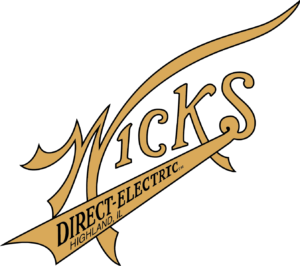A love of music and crafting the most beautiful sounding and esthetically magnificent organs has been at the center of our passion for three generations.
This heritage of craftsmanship continues even today as Scott Wick, the third generation of family ownership, guides the company into its second century.
The Wicks Organ Company started in the early 1900’s on the second floor of a jewelry and watch-making store in Highland, Illinois. The local Catholic priest had asked John Wick to study organ and become the church organist. Soon the parish wanted a new pipe organ to replace their aging reed organ, so John, with the help of his brothers, Louis and Adolph, started to work. Using their talents as a watchmaker, a cabinet maker, and a jeweler, the three Wicks created a small mechanical action instrument that successfully met the needs of their church.
It wasn’t long before nearby churches heard of their work, and wanted the same for their growing parishes. The Wicks created more of their instruments, and interest in organs built right here in Illinois grew. By 1908, the three Wicks began producing pipe organs for homes and churches in Illinois, Indiana, Missouri, and eventually almost every state in the country.
The Wicks initially used all mechanical action, but with the advent of electricity and electric blowers, began to experiment with electro-pneumatic actions. There are surviving examples of their work today, but John Wick thought that surely an organ could be operated purely electrically, avoiding the difficulties of pneumatic actions. Such pneumatic actions required frequent total releathering, and were susceptible to dirt, air pollution, changes in weather and moisture. Additionally, the winding and layout of the organ had to be designed with the action in mind, not the pipework, or the amount of space available to the organ. When difficulties did occur in these actions, repair and service were incredibly difficult.
By 1914, Wicks had perfected their electric action. Named DIRECT-ELECTRIC® for the electrical connection directly from the key to the valve, this small device remedied all of the difficulties of the pneumatic actions. The DIRECT-ELECTRIC® units had only one moving part, no perishable materials, could be arranged in any fashion one could dream of, were easily serviceable, and could function under any given wind pressure. Their single moving part made their reaction time immediate. The DIRECT-ELECTRIC®Action was patented in 1922, and again in 1929, based on improvements.
The organ world, unlike the fast-moving world of technology, was slow to grasp a new idea. There were some tough years for the Wicks as they began to use the DIRECT-ELECTRIC® action, but in hindsight, one can see the great opportunities this action brought to the company. In their first 13 years of building pneumatic and mechanical action instruments, the Wicks built 275 instruments. In the 15 years after inventing DIRECT-ELECTRIC® action, the Wicks opus list grew to over 1000.
Wicks continued to build instruments for the many small churches around the Illinois and Missouri countryside. Most of these organs are still playing today, a testament to the longevity of the Wicks DIRECT-ELECTRIC® action. Many people considered Wicks a builder of only small organs, but that is just one part of the Wicks history. Many large instruments have come out of the Wicks shop, including the 82 rank organ at First Baptist Church in Memphis, and the 92 rank instrument at Morehouse College in Atlanta. Wicks has been proud to be part of many large restoration projects as well, such as the implementation of DIRECT-ELECTRIC® action in the Aeolian-Skinner organ in the National Cathedral in Washington, D.C., and the restoration and enlargement of the 118 rank Kilgen/Moller instrument in the Cathedral Basilica in St. Louis.
The first Wicks pipe organ is still playing today, proving that durability, reliability, and longevity are foundations of the Wicks Organ heritage. Today the third generation of the Wick family continues the deep, rich family legacy with a renewed focus on the traditions of quality, innovation, and customer satisfaction. We know our organs will be around for many years, and so will we.
